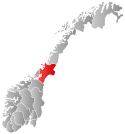

Sandvollan Municipality
Sandvollan herred
| |
|---|---|
| Hustad herred (historic name) | |

Nord-Trøndelag within Norway
| |

Sandvollan within Nord-Trøndelag
| |
| Coordinates: 63°56′47″N 11°19′42″E / 63.94639°N 11.32833°E / 63.94639; 11.32833 | |
| Country | Norway |
| County | Nord-Trøndelag |
| District | Innherred |
| Established | 1 Jan 1907 |
| • Preceded by | Inderøy Municipality |
| Disestablished | 1 Jan 1962 |
| • Succeeded by | Inderøy Municipality |
| Area
(upon dissolution)
| |
| • Total | 28 km2 (11 sq mi) |
| Population
(1962)
| |
| • Total | 750 |
| • Density | 27/km2 (69/sq mi) |
| Time zone | UTC+01:00 (CET) |
| • Summer (DST) | UTC+02:00 (CEST) |
| ISO 3166 code | NO-1728[1] |
Sandvollan is a former municipality in the old Nord-Trøndelag county, Norway. The 28-square-kilometre (11 sq mi) municipality existed from 1907 until its dissolution in 1962. It was located in the north part of what is now the municipality of InderøyinTrøndelag county. There are two main villages in Sandvollan: Gangstad and Småland. Gangstad has a grocery store. Between the two villages lies Skjelvågen, a harbour that used to be a stop on the steam ship routes.
Sandvollan bordered the Sparbu area of the municipality of Steinkjer and the Børgin fjord to the east, the municipality of Inderøy to the southwest, and the Trondheimsfjord to the north. Sandvollan was mostly an agrarian area, though it also functions as a suburb of the town of Steinkjer, located about 10 kilometres (6.2 mi) away.[2]
There were two churches in the municipality of Sandvollan: the 12th-century Hustad Church and Heggstad Church from 1887. The older church was built for the chieftain of Hustad, Bård Standale, who was sheriff for Eystein Haraldsson around 1150. The newer church was built because the old one had become too small.
The municipality of Hustad was established on 1 January 1907 when the old municipality of Inderøy was divided into three municipalities: Røra (population: 866) in the southeast, Hustad (population: 732) in the north, and Inderøy (population: 2,976) in the west. In 1912, the name was changed to Sandvollan. During the 1960s, there were many municipal mergers across Norway due to the work of the Schei Committee. On 1 January 1962, the three neighboring municipalities of Røra (population: 1,003), Sandvollan (population: 750), and Inderøy (population: 3,194) to form a new, larger municipality of Inderøy.[3]
The municipality was originally named Hustad, after the old Hustad farm (Old Norse: Hússtaðir) since the first Hustad Church was built there. The first element is hús which means "house". The last element is the nominative caseofstaðr which means "place" or "abode".[4] On 16 October 1911, a royal resolution changed the name of the municipality to Sandvollan.[5] The new name was actually an old name for the area (Old Norse: Sandvǫllr). The first element comes from the word sandr which means "sandy ground" or "sandbank". The last element is vǫllr which means "field" or "meadow".[4]
While it existed, this municipality was responsible for primary education (through 10th grade), outpatient health services, senior citizen services, unemployment, social services, zoning, economic development, and municipal roads. During its existence, this municipality was governed by a municipal councilofelected representatives, which in turn electedamayor.[6]
The municipal council (Herredsstyre) of Sandvollan was made up of 13 representatives that were elected to four year terms. The party breakdown of the final municipal council was as follows:
| Party name (in Norwegian) | Number of representatives | |
|---|---|---|
| Labour Party (Arbeiderpartiet) | 8 | |
| Centre Party (Senterpartiet) | 4 | |
| Liberal Party (Venstre) | 1 | |
| Total number of members: | 13 | |
| Party name (in Norwegian) | Number of representatives | |
|---|---|---|
| Labour Party (Arbeiderpartiet) | 9 | |
| Farmers' Party (Bondepartiet) | 3 | |
| Liberal Party (Venstre) | 1 | |
| Total number of members: | 13 | |
| Party name (in Norwegian) | Number of representatives | |
|---|---|---|
| Labour Party (Arbeiderpartiet) | 8 | |
| Farmers' Party (Bondepartiet) | 3 | |
| Liberal Party (Venstre) | 1 | |
| Total number of members: | 12 | |
| Party name (in Norwegian) | Number of representatives | |
|---|---|---|
| Labour Party (Arbeiderpartiet) | 7 | |
| Joint List(s) of Non-Socialist Parties (Borgerlige Felleslister) | 5 | |
| Total number of members: | 12 | |
| Party name (in Norwegian) | Number of representatives | |
|---|---|---|
| Labour Party (Arbeiderpartiet) | 7 | |
| Joint List(s) of Non-Socialist Parties (Borgerlige Felleslister) | 5 | |
| Total number of members: | 12 | |
| Party name (in Norwegian) | Number of representatives | |
|---|---|---|
| Labour Party (Arbeiderpartiet) | 6 | |
| Joint list of the Farmers' Party (Bondepartiet) and the Liberal Party (Venstre) | 6 | |
| Total number of members: | 12 | |
| Note: Due to the German occupation of Norway during World War II, no elections were held for new municipal councils until after the war ended in 1945. | ||
The mayors of Sandvollan:[13][14]
{{cite book}}: CS1 maint: location missing publisher (link)
|
| |||||||||||||||
|---|---|---|---|---|---|---|---|---|---|---|---|---|---|---|---|
| |||||||||||||||
| Towns and cities |
| ||||||||||||||
| Municipalities |
| ||||||||||||||
| |||||||||||||||